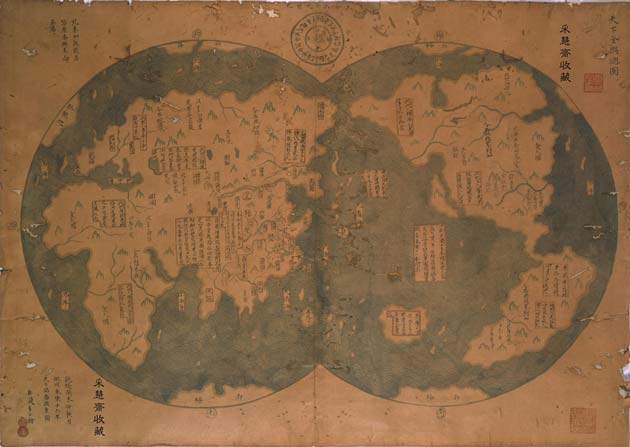Map Fuels Debate: Did Chinese Sail to New World First?

Tattered and rusty orange, a map recently unfurled in Beijing has reignited an international war of words over who reached the New World first.
China is the latest to throw its sailor hat into the ring, but it won't likely be the last in this long-running, hotly contested debate.
The Chinese voyage to America theory was popularized by British amateur historian Gavin Menzies in his 2002 book entitled "1421: the Year China Discovered America." The controversial, bestselling work claims that Chinese admiral Zheng He reached the Americas more than 70 years prior to Christopher Columbus' famous voyage.
After reading "1421," Liu Gang, a Chinese lawyer, realized the potential significance of a map he'd purchased for his private collection. Dated 1418 and clearly depicting the outlines of both North and South America, the map could be used to support Menzies' theory if it proves legitimate.
Forgery?
Liu unveiled his map at a packed press conference in Beijing on Jan. 16.
Despite arousing immediate international interest, the map was quickly dismissed by many historians as an outright forgery.
Sign up for the Live Science daily newsletter now
Get the world’s most fascinating discoveries delivered straight to your inbox.
"Scholars who know this field have refuted this claim under no uncertain terms," Sally K. Church, Fellow at the University of Cambridge, told LiveScience.
Geoff Wade, Senior Research Fellow at the University of Singapore's Asia Research Institute, echoed her sentiment. "The map is an 18th-century copy of a European map, as evidenced by the two hemispheres depicted, the continents shown and the non-maritime detailed [sic] depicted," he wrote recently to a group of maritime scholars.
In the other camp, Menzies is supporting Liu and the 1418 map with fervor. His key reasoning, forwarded by email from a member of his staff, is that "every continent, ocean, land, island, river shown on the 1418 map also appears on other Chinese maps of the same date or earlier. There is nothing new on the 1418 map—it simply combines everything on one sheet of paper," he said.
Menzies also points to a Portuguese map of the Americas dating from 1419 whose mistakes—like the drawing of California as an island—are thought to have been copied from cartographic errors made by the Chinese.
"In 1419 European voyages of exploration had not started. If the 1418 map is a forgery, then the 1419 map must be as well. How do you forge something yet to be discovered," Menzies reasoned.
British magazine The Economist recently printed an article about Liu's prized possession, quoting both supporters and detractors of Menzies' beliefs.
In a letter written to The Economist and provided to LiveScience, Wade, the critic of the map from the Asia Research Institute, urged its editor to print a retraction.
"That your writer has contributed to the Menzies' bandwagon and continuing deception of the public is saddening," Wade wrote. "The support mentioned all comes from Mr. Menzies' band of acolytes and the claims have no academic support whatsoever. Your writer has been taken in by Mr. Menzies and you do have a social responsibility to rectify this."
Other claims
The Chinese map controversy can be added to a growing database of claims for pre-Columbian discovery of the Americas.
According to some scholars, it was Scottish Earl Sir Henry Sinclair of Orkney who first touched American land in 1397, on one of many voyages the sailor undertook with Italian partner Nicolo Zeno. Another controversial map drawn by Zeno himself is thought to outline the coasts of Nova Scotia.
Supporters of this theory offer as evidence Sinclair's known contact with nearby Viking lords, whose ancestors unequivocally did reach North America centuries prior to any other Europeans—a feat that's often forgotten in the mix.
For now, a rewrite of the history books is unnecessary, according to Wade. "There is no need to rewrite anything except the history of 21st-century charlatans," he said.
Why is yawning contagious?
Scientific consensus shows race is a human invention, not biological reality










